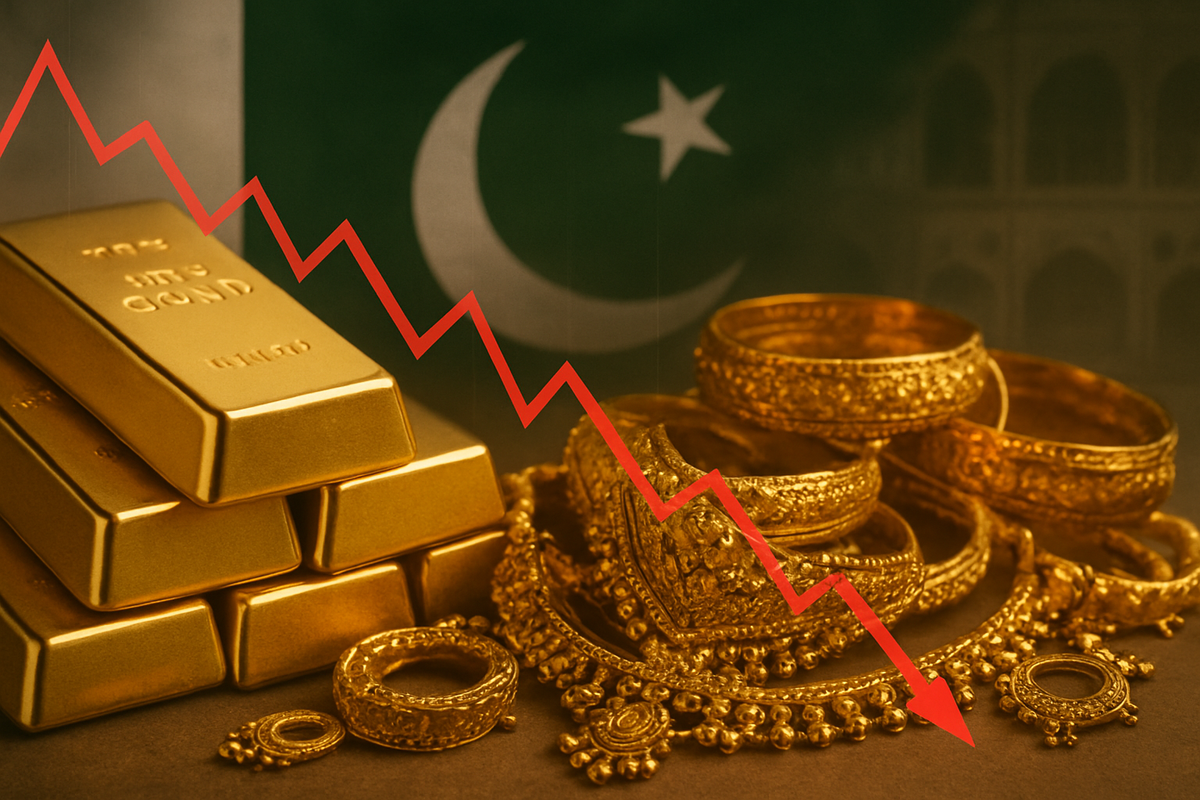
Karachi, Pakistan – November 20, 2025 – Gold prices in Pakistan have experienced a significant downturn, closely mirroring a decline in the international bullion market. This notable reduction, particularly pronounced in mid-November 2025, is providing a mixed bag of relief and caution for the local market and consumers, impacting investment strategies and purchasing behavior across the nation.
The drop in local gold rates, which saw 24-karat gold fall by Rs5,000 per tola on November 20, settling at Rs426,562, comes after a period of considerable volatility. This immediate decrease is a direct consequence of a sharp decline in global spot gold prices, which shed approximately $50 per ounce to trade around $4,042 an ounce on the same day. This synchronized movement underscores the profound interconnectedness of Pakistan's gold market with global economic forces, offering a potential buying opportunity for consumers while prompting investors to re-evaluate their positions.
A Turbulent Week: Unpacking the Gold Price Correction
The recent nosedive in Pakistani gold prices is not an isolated event but rather the culmination of a turbulent week in the global bullion market. On November 20, 2025, the All-Pakistan Gems and Jewellers Sarafa Association (APGJSA) reported a substantial drop, bringing the price of 24-karat gold to Rs426,562 per tola and 10 grams to Rs365,708. This followed a brief surge on November 19, where prices had climbed by Rs7,900 per tola, reaching Rs431,562, in response to international gains. However, this uptick was short-lived, as the broader downward trend, which saw drops of up to Rs7,000 per tola earlier in the week (around November 17-19), reasserted itself.
The primary driver behind this local correction is the performance of the international gold market. Global spot gold prices, after touching record highs of over $4,300 per ounce in October 2025, have been on a downward trajectory. By November 17, prices had already fallen to around $4,019.12 per ounce, continuing a multi-session slide. Several global macroeconomic factors are at play, including a strengthening US dollar, which makes dollar-denominated gold more expensive for international buyers, thereby dampening demand. Furthermore, receding expectations for an interest rate cut by the US Federal Reserve in December have diminished gold's appeal as a non-yielding asset. Investors are keenly watching upcoming US economic data, particularly employment reports, which are expected to heavily influence the Federal Reserve's monetary policy direction. Improved risk sentiment in equity markets has also drawn capital away from safe-haven assets like gold, contributing to the selling pressure, coupled with a wave of profit-taking after the commodity's recent record-breaking run.
Key stakeholders in this scenario include the APGJSA, which tracks and reports local gold prices, and the myriad of local jewelers and bullion traders who are directly impacted by these fluctuations. Consumers, particularly those planning weddings or looking for investment opportunities, represent another critical segment. Initial market reactions have been cautious; while some consumers might delay purchases anticipating further drops, others are seizing the moment to acquire gold at what they perceive as a more favorable entry point. Local jewelers note a tempered buyer enthusiasm, despite the ongoing wedding season, as the downward trend creates uncertainty.
Corporate Fortunes in Flux: Winners and Losers in the Gold Market Shift
The significant reduction in gold prices, both internationally and domestically in Pakistan, creates a ripple effect across various sectors, leading to potential winners and losers among public companies and market participants.
Companies involved in gold mining and refining, particularly those with international operations, may experience a direct impact on their revenues and profitability. A sustained decline in gold prices could squeeze profit margins for miners, especially those with higher production costs. While Pakistan has limited large-scale public gold mining operations, international players like Barrick Gold Corporation (NYSE: GOLD) or Newmont Corporation (NYSE: NEM), which operate globally, would see their valuations and earnings influenced by the broader international price trends. For such companies, hedging strategies and cost efficiency become paramount in a declining price environment. Conversely, a sharp rebound in gold prices would benefit these companies, boosting their top and bottom lines.
On the local front, jewelry retailers and manufacturers are at the forefront of this market shift. Companies such as ARY Jewellers (not publicly traded but a major player) and numerous smaller, unlisted entities form the backbone of Pakistan's gold trade. A reduction in gold prices can stimulate consumer demand, particularly during peak seasons like weddings and festivals, as gold becomes more affordable. This could lead to increased sales volumes for retailers, potentially offsetting any margin compression if they can manage their inventory effectively. However, if consumers anticipate further price drops, they might delay purchases, leading to sluggish sales for jewelers. Conversely, a sudden surge in prices after inventory has been acquired at lower rates could lead to higher profit margins for retailers. Financial institutions that offer gold-backed loans or invest in gold-related instruments might also see shifts in their asset values and loan portfolios. Furthermore, companies involved in the import of gold into Pakistan could benefit from lower international prices, provided the Pakistani Rupee's stability allows for favorable exchange rates.
The broader economic impact also extends to companies dealing in luxury goods and discretionary spending. If consumers feel wealthier due to lower gold prices (and thus potentially higher purchasing power for other goods), it could indirectly benefit companies in other consumer sectors. However, given the current high inflation and reduced purchasing power in Pakistan, the primary impact is likely to be concentrated within the gold and jewelry sector itself. Investors in gold exchange-traded funds (ETFs) or other gold-linked financial products would also see direct fluctuations in their portfolio values, aligning with the international price movements.
Broader Implications: A Shifting Landscape for Investment and Policy
The recent plunge in gold prices in Pakistan, driven by international market dynamics, carries wider significance beyond immediate consumer purchasing decisions, signaling shifts in broader industry trends, potential ripple effects, and even regulatory considerations. This event underscores the interconnectedness of global financial markets and the unique position of gold in Pakistan's economy.
Globally, the decline in gold prices fits into a broader trend influenced by monetary policy expectations and currency strength. The fading anticipation of aggressive interest rate cuts by the US Federal Reserve, coupled with a strengthening US dollar, reduces the attractiveness of non-yielding assets like gold. This trend aligns with a general move away from safe-haven assets when risk sentiment in equity markets improves. For Pakistan, this means that even as the local rupee faces pressure, the overwhelming influence of international gold prices can still lead to a local reduction, demonstrating that global macroeconomic factors can sometimes overshadow domestic currency depreciation in determining gold's value. This dynamic has potential ripple effects on competitors and partners; for instance, neighboring countries with similar gold import and consumption patterns might experience parallel market movements, influencing regional trade flows of bullion.
From a regulatory or policy perspective, sustained volatility in gold prices could prompt authorities to review import duties, taxes, or policies related to gold trade to stabilize the local market or manage foreign exchange reserves. While no immediate policy changes have been announced, significant and prolonged price swings could trigger such considerations. Historically, gold has served as a critical hedge against inflation and currency depreciation in Pakistan, making its price stability a matter of economic interest. Comparisons to similar events in the past, where international economic shifts directly impacted local gold markets, highlight the recurring vulnerability of the Pakistani market to global forces. For example, during periods of global financial crises or significant shifts in central bank policies, gold prices have historically reacted sharply, with local markets following suit. This reinforces gold's dual role as both a commodity and a monetary asset.
The event also highlights a potential shift in investor psychology. While gold has traditionally been a go-to investment in Pakistan during times of economic uncertainty and rupee depreciation, a significant and sustained international decline could challenge this perception, prompting some investors to explore alternative asset classes or re-evaluate their risk exposure. However, for a large segment of the population, gold's cultural significance and tangible nature continue to cement its role as a preferred store of value.
The Road Ahead: Navigating Gold's Volatile Future
As gold prices continue their volatile dance, both globally and within Pakistan, the road ahead presents a complex interplay of short-term opportunities and long-term strategic challenges for investors, consumers, and market participants. The current environment demands careful observation and adaptive strategies.
In the short term, the reduced gold prices offer a potential window of opportunity for consumers and investors who have been waiting on the sidelines. For individuals, this could be an opportune moment to purchase jewelry for personal use or as gifts, especially with the wedding season often driving demand. For strategic investors, the dip might be viewed as a favorable entry point, assuming a belief in gold's long-term value as a hedge against inflation and economic uncertainty. However, the risk of further declines, influenced by upcoming US economic data and Federal Reserve policy decisions, remains a significant factor, potentially leading some to delay purchases in anticipation of even lower prices. This "wait-and-see" approach could lead to continued subdued demand in the immediate future, despite the lower price points.
Looking further ahead, the long-term trajectory of gold prices will largely depend on global macroeconomic trends, particularly the US dollar's strength, inflation outlooks, and central bank monetary policies. If global inflation persists or geopolitical tensions escalate, gold's safe-haven appeal could resurface, driving prices upward. Conversely, a sustained period of global economic stability, coupled with higher interest rates, could keep gold under pressure. For Pakistani consumers and investors, strategic pivots or adaptations may involve diversifying investment portfolios beyond gold, exploring other asset classes, or adopting a more dynamic approach to gold acquisition, perhaps through dollar-denominated gold products to mitigate local currency risks. Market opportunities may emerge for entities involved in gold recycling or refining, as lower prices could stimulate the sale of old gold, increasing supply for these businesses.
Potential scenarios range from a rapid rebound if global economic uncertainties intensify or if the Federal Reserve signals a more dovish stance, to a prolonged period of consolidation or even further decline if strong economic data in major economies supports a tighter monetary policy. Outcomes for the Pakistani market will heavily depend on how these international factors interact with domestic economic conditions, including the stability of the Pakistani Rupee and local inflation rates. Businesses in the gold sector will need to adapt by managing inventory prudently, exploring new marketing strategies to capitalize on affordability, and potentially hedging against price fluctuations.
Wrapping Up: Key Takeaways and Future Outlook
The recent significant reduction in gold prices in Pakistan, directly influenced by a downturn in the international market, serves as a powerful reminder of the global interconnectedness of financial assets and the unique role gold plays in both investment portfolios and cultural traditions. The primary takeaway is the immediate relief offered to Pakistani consumers, who now have a potentially more affordable entry point into the gold market, albeit with the caveat of ongoing price volatility.
Moving forward, the market remains dynamic, characterized by a delicate balance of global economic indicators, currency fluctuations, and evolving investor sentiment. While the current dip presents buying opportunities, especially for those with a long-term perspective on gold's value as a hedge, it also highlights the risks associated with market timing. The strong correlation between local and international gold prices underscores that while domestic factors like rupee depreciation do play a role, global macroeconomic forces, particularly those emanating from the US, often exert a more dominant influence on bullion rates.
Investors in Pakistan should continue to watch for key developments in the coming months, including upcoming US economic data, particularly inflation and employment reports, and any shifts in the US Federal Reserve's monetary policy stance. Geopolitical events and the performance of the US dollar will also be crucial determinants of gold's future trajectory. For those considering gold as an investment, a diversified approach and a keen awareness of both international and domestic market signals will be essential. The current scenario is a testament to gold's enduring appeal as a tangible asset, but also to its susceptibility to the broader currents of the global financial landscape.
This content is intended for informational purposes only and is not financial advice





